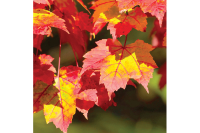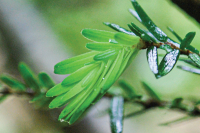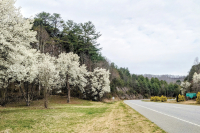Robin redbreasts are a perennial favorite
Our elementary school primers were populated by robins pulling worms out of holes. They appeared on television screens on Saturday mornings, hopping about in Disney cartoons that represented “the idea of a bird.” We know what a robin looks like in outline, but do we know much about the real thing?
You’re going the wrong way – not
When you’re out chasing fall migrants and you either have a good internal compass or you’re somewhere it’s pretty easy to orient yourself to the cardinal directions, like the Blue Ridge Parkway, it’s not unusual to find mixed flocks of migrants moving in what appears, intuitively, to be a “wrong” direction. You may find groups of birds moving north, or east, or west rather than the general southwest route we expect here in the mountains of Western North Carolina. These early morning flights — usually just after sunrise — are called “redetermined” flights.
Must have been an omen
When I checked my email Friday morning (9/9), I had a message from Chris Kelly, mountain wildlife diversity biologist with North Carolina Natural Resources Commission. Kelly helps coordinate an annual nightjar (birds of the family Caprimulgidae like Chuck-will’s-widow and whip-poor-will) survey across the mountains of North Carolina for the national Nightjar Survey Network. The email was an update for those who volunteer for the nightjar survey but it started out with a note that, “It is Common Nighthawk migration time!”
Ma Nature doesn’t see things the way we do
The red-cockaded woodpecker (RCWO) is a small – cardinal-sized – woodpecker native to eastern pine forests. It once ranged from New Jersey southward to Florida and westward to eastern Texas and portions of Oklahoma and Missouri. The RCWO is dependant upon old growth pine forests, especially longleaf pine.
Winged wonder: Bird study gets up close with WNC’s avian residents
Cloud cover keeps the summer morning cool as Mark Hopey makes the rounds below Cowee Mound. By 8:30 a.m., he and his two wildlife technicians have already been working at the Franklin-area site for nearly three hours, making hay while the sun doesn’t shine — or at least doesn’t shine with the heat it will gather soon.
Hopey glances down a small trail leading to a net — higher than his head, wide as a volleyball net and strung with fine black netting — before walking on past. No birds there, but he’ll inspect it closer on the way back, just to make sure.
Canucks amongst us
 You’re hiking streamside through a rhododendron tangle when you hear a short, musical trill – it kind of mimics the riffles in the stream. I know, you’re in a hurry – got a lot of hiking to do. But if you have a minute to track this little chorister down you won’t be disappointed. What you’re hearing is a Canada warbler.
You’re hiking streamside through a rhododendron tangle when you hear a short, musical trill – it kind of mimics the riffles in the stream. I know, you’re in a hurry – got a lot of hiking to do. But if you have a minute to track this little chorister down you won’t be disappointed. What you’re hearing is a Canada warbler.
Evolution
 I spend six weeks every spring doing bird surveys for the Forest Service across Western North Carolina. My travels take me from Hiwassee Dam, to Lake Chatuge, to Black Balsam, to Hot Springs, to the Pinks Beds, to Roan Mountain, Mount Mitchell, Roaring Creek and Boone Fork plus other locations.
I spend six weeks every spring doing bird surveys for the Forest Service across Western North Carolina. My travels take me from Hiwassee Dam, to Lake Chatuge, to Black Balsam, to Hot Springs, to the Pinks Beds, to Roan Mountain, Mount Mitchell, Roaring Creek and Boone Fork plus other locations.
32 years and counting for birding expedition
 This past weekend marked the occasion of the 32nd annual Great Smokies Birding Expedition. Fred Alsop, the ornithologist at East Tennessee State University, Rick Pyeritz, the now-retired physician at UNCA, and I initiated the event in the fall of 1984. Since 1985, it has been held the first or second weekend in May.
This past weekend marked the occasion of the 32nd annual Great Smokies Birding Expedition. Fred Alsop, the ornithologist at East Tennessee State University, Rick Pyeritz, the now-retired physician at UNCA, and I initiated the event in the fall of 1984. Since 1985, it has been held the first or second weekend in May.
Smoky birds
 I just finished four wonderful days of birding in the Smokies, helping out with the 66th Annual Spring Wildflower Pilgrimage. Well 3.8 wonderful days and 0.2 days getting drenched last Friday before we gave up. Man those pilgrims are tough!
I just finished four wonderful days of birding in the Smokies, helping out with the 66th Annual Spring Wildflower Pilgrimage. Well 3.8 wonderful days and 0.2 days getting drenched last Friday before we gave up. Man those pilgrims are tough!
Mystery solved
 I was having my morning coffee on the small floating dock in the narrow, clear Weeki Wachee River about three miles upstream of the Gulf of Mexico and watching for manatees. The girls and I had discovered that early morning was a good time to catch these unique creatures headed in or out of the river. The loud, incessant calling of a red-shouldered hawk from the woods across the river suddenly shattered the morning quiet.
I was having my morning coffee on the small floating dock in the narrow, clear Weeki Wachee River about three miles upstream of the Gulf of Mexico and watching for manatees. The girls and I had discovered that early morning was a good time to catch these unique creatures headed in or out of the river. The loud, incessant calling of a red-shouldered hawk from the woods across the river suddenly shattered the morning quiet.









